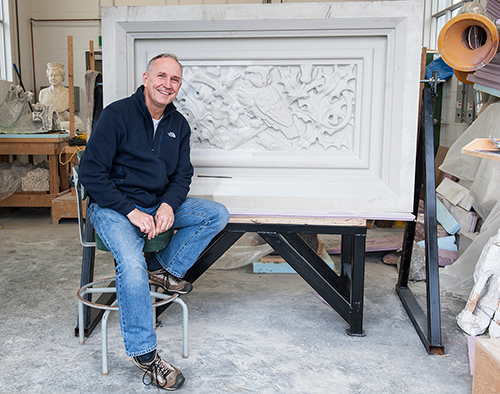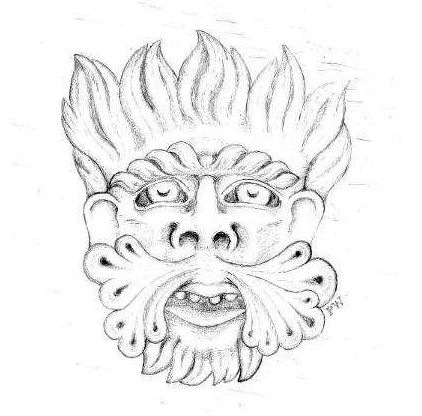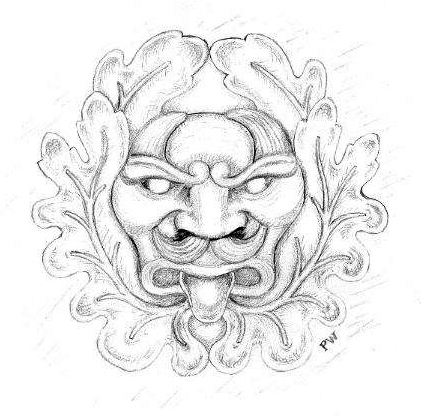Grotesque green men: A new project for the Dominion Sculptor
June 2016
Designing grotesque, wild, horned and foliated green men is all in a day’s work for Phil White, Canada’s Dominion Sculptor.

Phil White, Dominion Sculptor
Mr. White works in the Heritage Conservation Directorate of the Real Property Branch at Public Services and Procurement Canada, the federal department responsible for the maintenance of the Parliament Buildings. He has been Canada’s official sculptor since 2006.
Canada has only had five Dominion Sculptors since the position was established in 1936. The role was created to fulfill the vision of the architect of the Centre Block, John Pearson. In his design, Mr. Pearson included some 3,000 blank stone blocks on the outside of the Centre Block and approximately 2,500 more on the inside. The stones were left empty so that future generations of sculptors could carve the ongoing story of Canada’s history and culture for decades and even centuries to come.
One of the best known Dominion Sculptors was Eleanor Milne, the only woman to hold the position. She was appointed in 1962 and retired in 1993. Her legacy includes 12 stained glass windows that represent Canada’s provinces and territories, the restoration of the linen ceiling in the House of Commons, and a 120-foot-long limestone sculpture of Canada’s history.
Since 2006, Mr. White has brought his own creativity to the role. As time takes its toll on the buildings, he is required to put more energy into conservation and restoration. But he still sculpts statues, portraits and decorative pieces, and continues carving our history into the stones of the Centre Block.
So where do the green men come into the story? Their connection to the Dominion Sculptor starts to make sense if you know that the term “green men” refers to an architectural sculpture of a face that includes some kind of foliage. As for grotesques, these are sculptures of distorted, fantastical human and animal forms. The Centre Block of Parliament alone has nearly 900 of these creatures perched up high on its outer walls.
Grotesques can be frightening, funny and even joyful. If you start looking for them, you’ll find them decorating churches, university buildings, town halls and, of course, Canada’s Parliament Buildings.
The Dominion Sculptor’s involvement with the grotesques came about when the Royal Canadian Mint approached him with an interesting proposal: would he design three coins based on the architectural sculptures found on Parliament Hill?
He had lots of carvings to choose from; the Parliament Buildings are decorated with Canadian fauna and flora, dinosaurs, unicorns, historical figures … and much more. Nobody knows them better than Canada’s official sculptor.
Once he had selected a few sculptures, Mr. White submitted a dozen sketches of mostly flora and fauna to the Mint. After further discussions, the Mint decided to feature medieval images on the coins.
The Dominion Sculptor studied the Parliament Buildings’ many carvings once again, examining more closely those with a medieval connection. In the end, he settled on the green men, which can be found on the Centre and East Blocks.
He then prepared drawings inspired by the three grotesques. It was a new challenge to translate three-dimensional carvings into low relief. The Mint was pleased with the designs, and the next step was to consult with the coin engravers.
The engravers and Mr. White talked at length about the tools and techniques that would have been used to carve the green men and how best to reflect the sculpted aspect of the grotesques on the coins.
The engravers were now ready to move into production, and, at the end of this year long project, the first coin was issued in January. The series is complete, and you can see the final result on the Mint’s website, where all three coins are for sale.
As the coins are purchased by collectors and aficionados, our three green men will have the opportunity to travel far beyond the walls of the Parliament Buildings. This first-ever collaboration between the Mint and the Dominion Sculptor will bring a small part of the magic and artistry of these magnificent buildings to a new audience.

Sketch for the Wild Green Man

Sketch for the Horned Green Man

Sketch for the Foliated Green Man
Questions for the Dominion Sculptor
Why is heritage conservation important?
I think it’s important to know our past and to know where we’re coming from. For example, the Centre Block is central to our national identity. It has dictated the direction of our country, and our history is carved into its walls. As the expression goes, “Those who forget their past are doomed to repeat it.”
What do you like best about your work?
The creativity and the location; to be able to use such a prominent space (the Parliament Buildings) as an open canvas. I have the opportunity to create new sculptures in a place where there were none and to have a fair bit of artistic freedom in doing that. It’s really a wonderful opportunity. And I like the research aspect too. I get to learn a lot of different things.
What is one of your favourite projects?
I would have to pick designing new altars for the Books of Remembrance in the Memorial Chamber. This is one of the few spaces for which we have a lot of written information from the architect. I wanted to respect his intentions for the space, and add to it in a meaningful way that didn’t overpower the artistic design of the room. I also wanted to be respectful of the subject of the chamber: tens of thousands of people who gave their lives for their country.
Follow us on Twitter and on Facebook.
- Date modified: